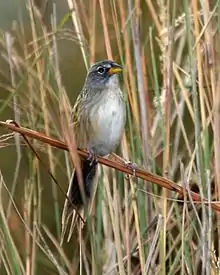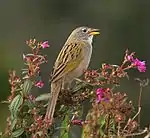Emberizoides
Emberizoides is a small genus of finch-like tanagers found in grassy areas in Central and South America.
| Emberizoides | |
|---|---|
 | |
| Lesser grass finch (Emberizoides ypiranganus) | |
| Scientific classification | |
| Kingdom: | Animalia |
| Phylum: | Chordata |
| Class: | Aves |
| Order: | Passeriformes |
| Family: | Thraupidae |
| Genus: | Emberizoides Temminck, 1822 |
| Type species | |
| Sylvia herbicola Vieillot, 1817 | |
| Species | |
| |
Taxonomy and species list
The genus Emberizoides was introduced in 1822 by the Dutch zoologist Coenraad Jacob Temminck.[1] The type species was later designated as the wedge-tailed grass finch by George Robert Gray.[2][3] The genus name combines the bunting genus Emberiza introduced by Carl Linnaeus in 1758 with the Ancient Greek -oidēs meaning "resembling".[4] This genus was traditionally placed with the buntings and New World sparrows in the subfamily Emberizinae within an expanded family Emberizidae.[3] A molecular phylogenetic study published in 2014 found that Emberizoides was embedded in the tanager family Thraupidae. Within this family, the genus is now placed with Embernagra and Coryphaspiza in the subfamily Emberizoidinae.[5][6]
The genus contains three species:[6]
| Image | Common Name | Scientific name | Distribution |
|---|---|---|---|
 | Wedge-tailed grass finch | Emberizoides herbicola | Argentina, Bolivia, Brazil, Colombia, Costa Rica, Ecuador, French Guiana, Guyana, Panama, Paraguay, Peru, Suriname, Uruguay, and Venezuela |
| Duida grass finch | Emberizoides duidae | Venezuela | |
 | Lesser grass finch | Emberizoides ypiranganus | Argentina, Brazil, Paraguay, and Uruguay |
References
- Temminck, Coenraad Jacob (1838). Nouveau recueil de planches coloriées d'oiseaux, pour servir de suite et de complément aux planches enluminées de Buffon (in French). Volume 3. Paris: F.G. Levrault. Plate 114 with text (Livraison 19). The title page is dated 1838 but the 5 volumes were originally issued in 102 livraison (parts) between 1820 and 1839. For a discussion of the dates see: Dickinson, E.C. (2001). "Systematic notes on Asian birds. 9. The Nouveau recueil de planches coloriées of Temminck & Laugier (1820–1839)". Zoologische verhandelingen Leiden. 335: 7–53.
- Gray, George Robert (1840). A List of the Genera of Birds : with an Indication of the Typical Species of Each Genus. London: R. and J.E. Taylor. p. 43.
- Paynter, Raymond A. Jr, ed. (1970). Check-List of Birds of the World. Volume 13. Cambridge, Massachusetts: Museum of Comparative Zoology. p. 129.
- Jobling, James A. (2010). The Helm Dictionary of Scientific Bird Names. London: Christopher Helm. p. 145. ISBN 978-1-4081-2501-4.
- Burns, K.J.; Shultz, A.J.; Title, P.O.; Mason, N.A.; Barker, F.K.; Klicka, J.; Lanyon, S.M.; Lovette, I.J. (2014). "Phylogenetics and diversification of tanagers (Passeriformes: Thraupidae), the largest radiation of Neotropical songbirds". Molecular Phylogenetics and Evolution. 75: 41–77. doi:10.1016/j.ympev.2014.02.006.
- Gill, Frank; Donsker, David; Rasmussen, Pamela, eds. (July 2020). "Tanagers and allies". IOC World Bird List Version 10.2. International Ornithologists' Union. Retrieved 20 November 2020.